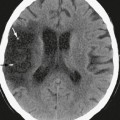CHAPTER 11 Deep Gray Nuclei and Related Fiber Tracts
The deep gray nuclei are the central masses of gray matter arrayed around the lateral and third ventricles, including the basal ganglia and thalami (Figs. 11-1 and 11-2).1–10 The specific nuclei within the deep gray matter have been grouped, reclassified, and designated by different names for different purposes.
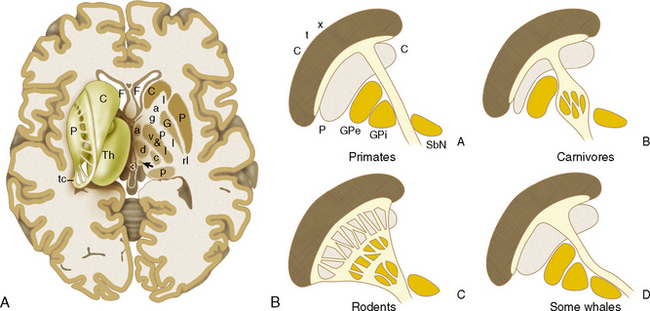
FIGURE 11-1 Diagrammatic summaries of the relationships among principal components of the basal ganglia and thalami. A, The caudate nucleus (C) has a bulbous head that indents the frontal horn (F) of the lateral ventricle. It has a short body that lies above the thalamus (Th) and a long curving tail (tc) that passes laterally and inferiorly into the roof of the temporal horn (below the plane of this section). The putamen (P) lies lateral to the caudate nucleus but is connected to it by multiple bridges of gray matter. The gray bridges extend superior to and posterior to the central mass of the putamen. They are shorter, thicker, and more numerous anteriorly and longer, thinner, and sparser posteriorly. The individual white matter fascicles of the internal capsule arc through the gaps between the gray bridges medial to and behind the putamen. In axial cross section, these fibers describe an anterior limb (al), genu (g), and posterior limb (pl) of the internal capsule. The globus pallidus (G) lies medial to the putamen (P) within the arc of the internal capsule. Individual laminae of white matter separate the putamen from the globus pallidus and subdivide the globus pallidus (not shown). The thalamus contains multiple individual nuclei, separated by an internal medullary lamina. This lamina divides anteriorly to enclose the anterior nucleus (a) and splits centrally to enclose the intralaminar nuclei, one of which is the centromedian nucleus (c). The dorsomedial nucleus (d) lies medial to the internal medullary lamina. A larger number of individual ventral (v) and lateral (l) thalamic nuclei lie lateral to the lamina. The pulvinar (p) makes up the posterior pole of the thalamus. It arises as part of the lateral group but expands markedly, deflecting the internal medullary lamina anterior to it. At the posterior end of the midline third ventricle (3), paired medial and lateral habenular nuclei (arrow) form small masses of gray matter. The portion of the internal capsule behind the lenticular nucleus is the retrolenticular (rl) internal capsule. A sublenticular portion lies below the putamen. The structures of the basal ganglia are commonly grouped in two overlapping ways. Because the caudate nucleus and the putamen are connected, both anatomically and functionally, they may well be considered one structure, designated the striatum. Because the putamen and globus pallidus take a sector shape in cross section, they are often grouped together as the lenticular (lentiform) nucleus. Thus, the putamen falls into two commonly used groups. B, Coronal diagrams of the relationship of the internal capsule to the cerebral cortex (pallium) (Ctx), caudate nucleus (C), putamen (P), lateral (external) segment of the globus pallidus (GPe), medial (internal) segment of the globus pallidus (GPi), and the substantia nigra (SbN) pars reticulata. Comparative anatomy shows that the arrangement in primates (A) is just one of a number of known variations. The internal capsule may pass between GPi and SbN (primates), penetrate through one (carnivores) or both (rodents) of these nuclei or pass entirely medial to both the GPi and the SbN (some whales). Note that in rodents the internal capsule penetrates the combined caudate and putamen without forming a defined fiber bundle.
(A, Modified from Daniels DL, Haughton VM, Naidich TP. Cranial and Spinal Magnetic Resonance Imaging. An Atlas and Guide. New York, Raven Press,1987, based on an original drawing by the late Robert Albertin, 1984. B, Modified from Nauta HJW. A Simplified Perspective on the Basal Ganglia and Their Relationships to the Limbic System. New York, Raven Press, 1986.)

FIGURE 11-2 Relationship of the basal ganglia and thalamus to the lateral ventricle. Fresh gross anatomic specimen viewed from the midline toward the lateral walls of the third and lateral ventricles. The caudate nucleus resembles the convex outer surface of the head of a golf club (driver). The outer borders of the caudate and nucleus accumbens septi (Ac) form a single smooth curve that is convex anteriorly. Behind the optic chiasm (II), the mammillary body (M), cerebral peduncle (cp), medial geniculate nucleus (MG), and the pulvinar (Pu) create four distinct arcs along the undersurface of the hypothalamus-thalamus. Continuing around, the superior surface of the thalamus from the pulvinar back to the caudate head forms another smooth single curvature. Together, the basal ganglia and the thalami resemble a figure-of-eight (infinity sign) placed on its side enclosed within the arc of the frontal horn (F), atrium (At), occipital horn (OH), and temporal horn (T). The striae medullares thalamorum (black arrows) course posteriorly and inferiorly along the medial wall of the thalamus, defining the position of the roof of the third ventricle (3V). The optic chiasm (II) and mammillary body (M) define the floor of the third ventricle. The white arrow occupies the foramen of Monro.
EMBRYOLOGY
By the end of the fifth week of gestation, a longitudinal hypothalamic sulcus appears along the inner aspect of the developing diencephalon.6,11,12 The hypothalamic sulcus delimits the future dorsal thalamus, metathalamus, and epithalamus that arise above the sulcus from the ventral thalamus and hypothalamus that arise below the sulcus. Ultimately, the dorsal thalamus will grow to form nearly all of the structure called thalamus in the adult. The ventral thalamus will remain small, forming the subthalamic nucleus, the reticular nuclei of the thalamus, and related fiber tracts.
By the end of the sixth week, an epithalamic swelling appears at the dorsal rim of the diencephalon separated from the thalamus by a dorsal (epithalamic) sulcus.11 Initially, this epithalamus projects into the cavity of the ventricle and is larger than the dorsal thalamus.6 A midline diverticulum of the epithalamic roof evaginates to form the pineal stalk. Proliferation of cells in the dorsal portion of that diverticulum forms the pineal gland. Paired paramedian habenular trigones with medial and lateral habenular nuclei develop in the lateral walls of the third ventricle, well inferior to their final position.
After the seventh week, the dorsal thalamus grows disproportionately to become the largest element of the diencephalon. This growth smooths out the dorsal (epithalamic) sulcus, displaces the epithalamus dorsally, and dwarfs the structures formed from the epithalamus.11 The pineal stalk remains hollow, ultimately forming the pineal recess of the third ventricle. Fibers from the habenular nuclei decussate in the superior wall of the hollow pineal stalk to make the habenular commissure. Fibers from the accessory optic nuclei decussate in the inferior wall of the pineal stalk to make the posterior commissure.6,9
With continued growth of the thalamus the intervening third ventricle becomes narrow. The paired thalami meet in the midline and fuse together to form the massa intermedia (interthalamic adhesion).6 Marked overgrowth of the telencephalic vesicles (future cerebral hemispheres) bulges them outward, so that they roll over and lateral to the thalami. The cleft between the telencephalic vesicles and the thalamus becomes narrowed and then obliterated, allowing the telencephalon to fuse with the dorsal surface of the diencephalon. The lamina affixa of the thalamus marks this line of fusion.
The embryonic telencephalon is divided into pallial and subpallial regions. The pallium gives rise to the dorsal structures, including the cerebral cortex. The subpallium gives rise to the ventral structures such as the striatum and pallidum.12 The future striatum appears during the sixth week as paired prominent swellings in the floors of the lateral ventricles. These ventricular eminences (synonym: ganglionic eminences) lie in the approximate position of the telencephalic-diencephalic fusion line.6 The medial ventricular eminence appears first and is responsible for generating the cholinergic interneurons of the striatum, pallidum, and basal forebrain.12 The lateral ventricular eminence develops later and is the principal source of GABAergic striatal neurons and mixed-transmitter striatal interneurons.12 With later development of the cerebral cortex, fibers passing to and from the future cerebral cortex will extend along the line between the striatum and the thalamus to form the internal capsule.6
BASAL GANGLIA AND RELATED STRUCTURES
Gray Matter Structures: Descriptions and Definitions
Traditionally, the term basal ganglia has identified the caudate nucleus, putamen, globus pallidus, claustrum, and amygdaloid complex.5,7 Some authors have also included the thalamus.9 More recently, it has been restricted to the set of closely grouped, multiply interconnected, and functionally integrated cell masses composed of the caudate nucleus, putamen, external and internal nucleus of the globus pallidus (GPe and GPi), subthalamic nucleus, and substantia nigra.9 The claustrum is now reclassified as a subinsular association area.9 The amygdala is better considered with the limbic system. The thalamus is described separately later in this chapter.
The caudate nucleus is an elongated C-shaped cell mass in the lateral wall of the lateral ventricle (Figs. 11-3 to 11-7; see also Figs. 11-1 and 11-2). Grossly, it has a bulbous head that indents the lateral wall of the frontal horn, a short body that lies along the lateral wall of the body of the lateral ventricle, and a long thin tail that curves along the lateral wall of the temporal horn to terminate in the posterior inferior putamen near the amygdala.3,5 The C shape of the caudate nucleus recapitulates both the C shape of the cerebral cortex arrayed around the sylvian fissure and the C shape of the lateral ventricle. For much of its length, the caudate nucleus abuts onto the superior lateral thalamus. Their junction forms the striothalamic groove (synonyms: caudothalamic groove, sulcus terminalis) (see Fig. 11-2).5 The stria and vena terminalis course along this groove deep to the ependyma.5
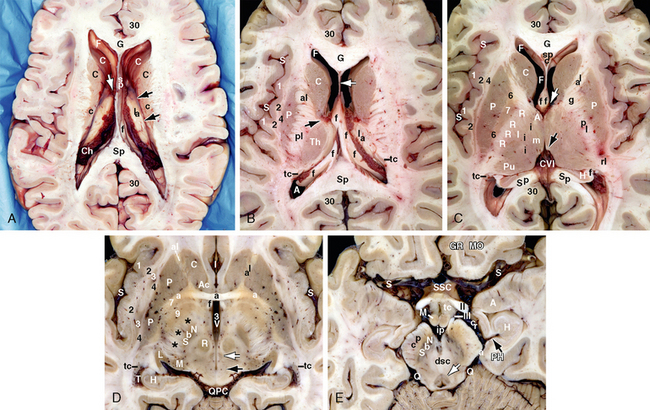
FIGURE 11-3 Axial anatomic sections through the basal ganglia displayed from superior to inferior. Two specimens. A, Specimen 1. Section through the lateral ventricles and septum pellucidum (sp) discloses the genu (G) and splenium (Sp) of the corpus callosum, the ependyma-covered head of the caudate nucleus (white C) that indents the frontal horn (F) giving it its shape, the body of the caudate nucleus (black C, c) forming the caudate stripe along the upper lateral wall of the body of the lateral ventricle, the striothalamic (caudothalamic) groove (black arrows) at the junction of the caudate with the upper surface of the thalamus, the lamina affixa (la) that encloses the superior surface of the thalamus laterally (deep to the ependyma), the fornix (f) that rests atop the thalamus medially, and the choroid plexus (Ch) that passes through the choroidal fissure to emerge into the ventricle between the lateral edge of the fornix and the lamina affixa on each side. The fibers traversing the internal capsule are seen to ascend/descend through the brain just lateral to the caudate stripe. The superior lateral angles of the ventricles are enclosed only by ependyma and white matter, not gray matter. White arrow, foramen of Monro; 30, cingulate gyrus. B to E, Specimen 2. B, Asymmetric section through the frontal horns (F), atria (A), genu (G), and splenium (Sp) shows the relationship of the fornix (f) to the thalamus (Th) and choroid plexus at two levels. The tails (tc) of the caudate nuclei course along the lateral borders of the atria (A) before descending along the superior lateral margins of the temporal horns. The lamellae of the brain deep to the sylvian fissure include the insular cortex (1), extreme capsule (2), claustrum (unlabeled), external capsule (4), putamen (P), and the internal capsule with its anterior (al) and posterior (pl) limbs crossed by the caudatolenticular bridges of gray matter. White arrow, septum pellucidum; black arrow, striothalamic (caudothalamic) groove. C, Section through the thalami shows, in addition, the lateral medullary lamina of the lenticular nucleus (6), the lateral nucleus of the globus pallidus (GPe) (7), the reticular nuclei of the thalami (approximately along the row of Rs), the ventral/ lateral nuclear groups of the thalamus (white l), the internal medullary lamina (black i) of the thalamus, the anterior nucleus (A), medial nucleus (m) and pulvinar (Pu) of the thalamus, the striae medullares thalamorum (black arrow) along the medial wall of the thalami, the cistern of the velum interpositum (CVI), the anterior columns of the fornices (f, f) creating the anteromedial walls of the foramina of Monro (white arrow) at the caudal end of the septum pellucidum, and the retropulvinaric portions of the fornices (f) enclosing the retropulvinaric hippocampal formations (H). The thin tail (tc) of the caudate nucleus descends along the lateral wall of the atrium toward the temporal horn. spc, small cavum septi pellucidi within the anterior septum. D, Section through the anterior commissure shows the “φ” configuration formed by the paired anterior columns of the fornices (f) descending behind the midline portion of the anterior commissure (a), the course of the anterior commissure through the lateral nucleus (7) of the globus pallidus, and the relation of the nucleus accumbens septi (Ac) and caudate nucleus to the anterior commissure (a) and anterior limb (al) of the internal capsule. The third ventricle (3V) transitions into the cerebral aqueduct. Posteriorly, the section shows the junction of the midbrain with the diencephalon and the transition (row of asterisks) from the internal capsule to the cerebral peduncle. The substantia nigra (SbN) and red nucleus (R) are ventral. The periaqueductal gray matter (black arrow) and oculomotor nucleus (CN III) (white arrow) lie more dorsally. The medial geniculate nucleus (M) lies at the side of the midbrain in the angle immediately posterior to the lateral edge of the cerebral peduncle. The lateral geniculate nucleus (L) lies further lateral and shows the characteristic notch in its inferior medial surface. The tails of the caudate nuclei (tc) descend along the lateral walls of the temporal horns. QPC, quadrigeminal plate cistern. E, Caudal section through the midbrain demonstrates the cerebral peduncle (cp) and substantia nigra (SbN) in relation to the decussation of the superior cerebellar peduncle (dsc), the aqueduct and periaqueductal gray matter, the oculomotor nucleus (white arrow), and the fibers of cranial nerve III (III) that emerge into the interpeduncular fossa (ip) along the medial border of the cerebral peduncle (cp). The optic chiasm (II), tuber cinereum (white tc), and mammillary bodies (M) lie within the suprasellar cistern (SSC). The perimesencephalic cistern comprises the interpeduncular fossa (ip) between the cerebral peduncles (cp), the crural cisterns (cr) between the midbrain and the uncus-hippocampal formation, the ambient cistern (a) between the midbrain and the parahippocampal gyrus (PH), and the quadrigeminal plate cistern (Q) between the midbrain and the medial cerebellum. GR, gyrus rectus; MO, medial orbital gyrus; S, sylvian fissure. The black arrow indicates the hippocampal fissure.
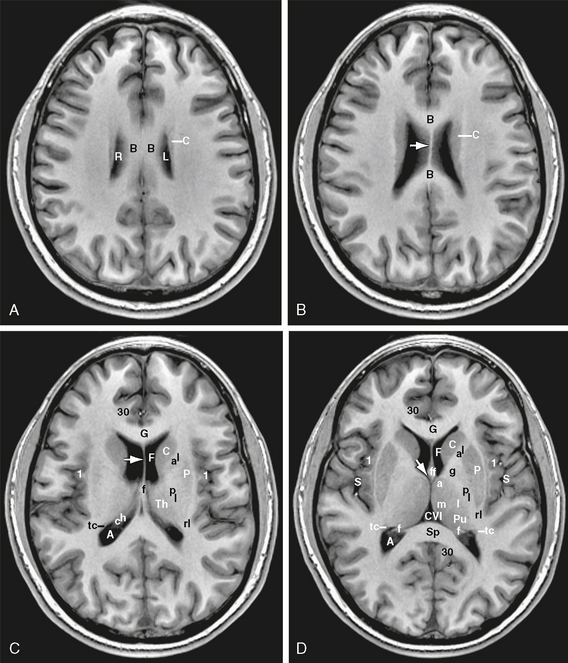
FIGURE 11-4 Axial T1W MR images displayed from superior to inferior. A and B, Upper sections. The body (B) of the corpus callosum and the septum pellucidum (single horizontal arrow) form the medial walls of the left (L) and right (R) lateral ventricles. The body of the caudate nucleus (C) forms a thin stripe of gray matter along the upper lateral walls. C and D, The head of the caudate nucleus (C) and the thalamus (Th) lie medial to the anterior limb (al) and posterior limb (pl) of the internal capsule. The putamen (P) lies laterally, enclosed within the arc of the anterior limb, posterior limb, and retrolenticular (rl) portions of the internal capsule. The tail of the caudate nucleus (tc) runs along the lateral wall of the atrium (A) before descending into the temporal lobe. The paired fornices from each side converge to form a single body (black f) of the fornix inferior to the body of the corpus callosum. Nuclear groups within the thalamus (Th) include the anterior nuclei (a), the dorsomedial (mediodorsal) nucleus (m), and the combined ventral and lateral nuclei (l), which include the pulvinar (Pu). On each side, the foramen of Monro (oblique arrow) lies between the anterior column of the fornix and the anterior nuclei of the thalamus. The cortex of the insula (1) delimits the lateral wall of the cerebrum at the level of the third ventricle and basal ganglia. 30, cingulate gyrus; ch, choroid plexus; CVI, cistern of the velum interpositum; Sp, splenium; S, sylvian fissure.
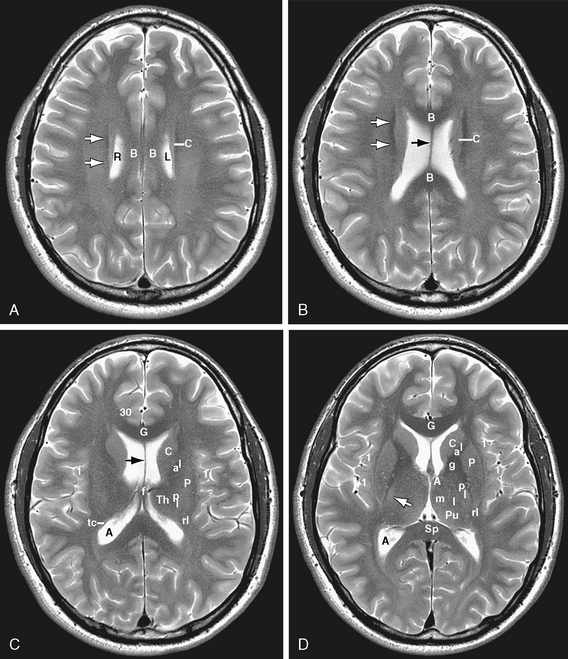
FIGURE 11-5 A to D, Corresponding axial T2W MR images displayed from superior to inferior. In B, the superior occipitofrontal fasciculi (white arrows) appear as low signal stripes of compact myelinated fibers roughly parallel to the lateral walls of the ventricles. In addition to the structures labeled in Figure 11-4, T2W MR images show the capsular anatomy more clearly, including higher signal within the corticospinal tracts (white arrow) as they traverse the posterior limb of the internal capsule, and the flow voids of the two internal cerebral veins within the cistern of the velum interpositum just anterior to the splenium (Sp). The black arrow in C indicates the septum pellucidum.
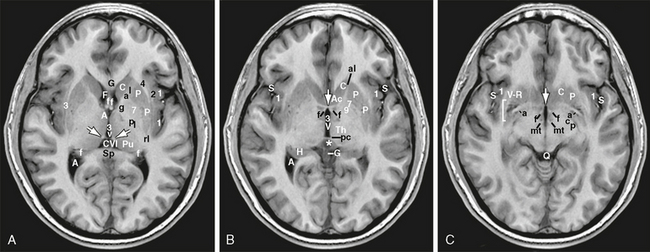
FIGURE 11-6 A to C, Serial axial T1W MR images displayed from superior to inferior. A, The anterior columns of the fornix (f, f) appear as two adjacent well-defined white matter tracts that make up the medial walls of the foramina of Monro at the inferior ends of the septum pellucidum. The posterior portions of the fornices (f, f) lie behind the pulvinars (Pu). The habenular trigones (paired white arrows) lie along the side walls of the posterior third ventricle (3V) at the anterolateral margins of the cistern of the velum interpositum (CVI). B, The fornices (f, f) then diverge slightly and pass behind the anterior commissure (vertical white arrow) creating a characteristic shape resembling the Greek letter “φ”. The anterior limbs (al) of the internal capsule touch the lateral margins of the “φ” at each side. The posterior commissure (pc) crosses the midline through the inferior wall of the stalk of the pineal gland (asterisk) at the posterior third ventricle. The axial plane through the top of the anterior commissure (AC) and the bottom of the posterior commissure (PC) is known as the AC-PC baseline of Talairach-Tournoux. G, vein of Galen; Ac, nucleus accumbens septi. C, From its midline segment (white arrow), the inferolateral portions (a, a) of the anterior commissure pass under the putamen in relation to the arteries and veins that pass through the anterior perforated substance to the basal ganglia. The perivascular (Virchow-Robin) spaces (bracket: V-R) surrounding these vessels characteristically encompass these specific segments (a, a) of the anterior commissure. The penetrating vessels and V-R spaces are characteristically more prominent anterolaterally than posteromedially. Behind the anterior commissure, the anterior columns of the fornices (f, f) continue inferiorly toward the mammillary bodies, and the mammillothalamic tracts (mt) ascend from the mammillary bodies toward the anterior nuclei of the thalami (seen on more superior sections). Q, quadrigeminal plate cistern. Other labels as indicated earlier.

FIGURE 11-7 A to C, Corresponding axial T2W MR images displayed from superior to inferior (labels as in Fig. 11-6). In A, the corticospinal tracts (white arrowhead) again display higher signal intensity, and the paired internal cerebral veins course through the cistern of the velum interpositum. In C, the two arrows indicate the anterior column of the fornix in front and the mammillothalamic tract behind. R, red nucleus; s, substantia nigra.
The nucleus accumbens is an inferomedial expansion of the caudate head. Grossly, it extends under the anterior portion of the lateral ventricle into the medial (septal) wall of the cerebral hemisphere, forming a prominent bulge (Fig. 11-8; see also Figs. 11-3D and 11-6B).9
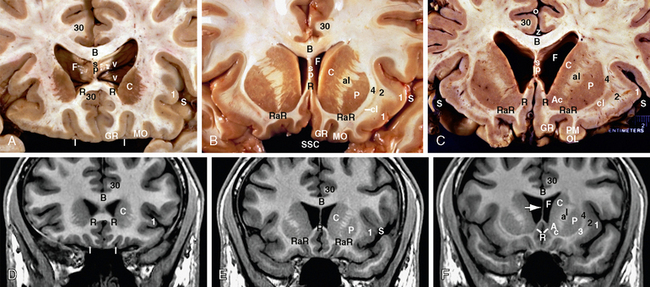
FIGURE 11-8 A to F, Coronal plane images and gross anatomic sections displayed from anterior to posterior. A, Section through the frontal horns (F) displays the cingulate gyrus (30) encircling the body (B) and rostrum (R) of the corpus callosum. The smooth medial border of the head of the caudate nucleus (C) indents the frontal horn. The lateral border of the caudate head is characteristically serrated where it gives rise to the caudatolenticular bridges of gray matter (gray bridges) that pass to the putamen (see next cuts). Subependymal veins (v v) on the anterior wall of the frontal horn converge to the septum. Inferiorly, cranial nerve (CN) I lies along the inferior surface of the olfactory sulcus between the gyrus rectus (GR) and the medial orbital gyrus (MO). Laterally, the sylvian fissure (S) and insula (1) form the lateral surface of the deep brain. B and C, Coronal sections display the caudate head (C) united to the putamen (P) through the nucleus accumbens septi (Ac) anterior inferior and medial to the anterior limb (al) of the internal capsule. Fibers radiating (RaR) through the rostrum (R) pass inferior to the deep gray nuclei, defining the lower border of the ganglia. Superiorly, the body of the corpus callosum (B), pericallosal sulcus (z), cingulate gyrus (30) and cingulate sulcus (o) define the upper border of the deep brain. Further posteriorly, the anterior limb (al) of the internal capsule wedges between the caudate head (C) and the putamen (P) to just “kiss” the anterior commissure (a) on each side. Residual gray bridges interconnect the caudate with the putamen across the anterior limb. This far anteriorly, the lenticular nuclei display only the putamen (P). Postero-inferiorly, the posteromedial orbital lobule (PMOL) projects back into the suprasellar cistern (SSC). D to F, Corresponding T1W coronal plane MR images displayed from anterior to posterior.
The putamen is the larger dark gray portion of the striatum that lies deep to the internal capsule and lateral to the globus pallidus (see later) (see Figs. 11-1 and 11-3 to 11-9).
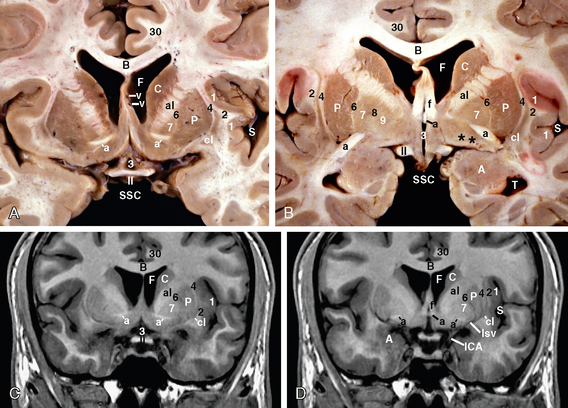
FIGURE 11-9 A to D, Coronal plane images. A, Coronal section through the genus of the anterior commissure shows the anterior limbs (al) of the internal capsules touching the anterior commissure just medial to the genus. The anterior commissure passes through the bottom of the lateral nucleus (7) of the globus pallidus. Septal veins (v) are seen along the medial wall of the frontal horns (F). II, optic chiasm; 3, third ventricle; SSC, suprasellar cistern. B, Straight coronal section through the apex of the lenticular nucleus. From lateral to medial the layers of gray (white numbers) and white (black numbers) matter form a coherent series: sylvian fissure (S), cortex of insula (1), extreme capsule (2), claustrum (3), external capsule (4), putamen (P), lateral lamina of the lenticular nucleus (6), lateral nucleus of the globus pallidus (GPe) (7), medial lamina of the lenticular nucleus (8), medial nucleus of the globus pallidus (GPi) (9), and internal capsule. The claustrum (cl) becomes more prominent inferiorly and extends medially through the substantia innominata (asterisks) to the amygdala (A). C and D, Corresponding T1W coronal plane MR images. A, amygdala; ICA, internal carotid artery; lsv, lenticulostriate vessels (arteries and/or veins). The supraoptic recess of the third ventricle (3) lies immediately superior to the optic chiasm (II). Other labels as in A and B.
The olfactory tubercle is the part of the anterior perforated substance that lies immediately posterior to the division of the olfactory tract into the medial and lateral olfactory striae on each side.9 The olfactory tubercle covers the superficial aspect of the nucleus accumbens and the head of the caudate nucleus. It receives direct sensory fibers from the olfactory bulb.
The term corpus striatum includes the caudate nucleus, the putamen, and the medial and lateral nuclei of the globus pallidus (Figs. 11-9 to 11-11).5 The name is said to derive from either the small-diameter, nonmyelinated to thinly myelinated striatal afferents and efferents that traverse these nuclei or the fiber bundles of the internal capsule that cross between the caudate nucleus and the putamen.
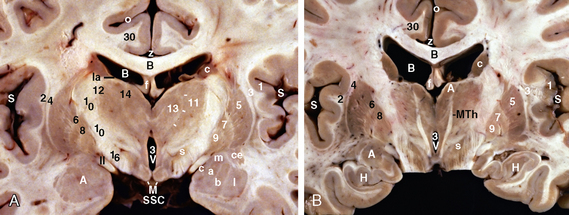
FIGURE 11-10 Gross anatomic coronal plane images displayed from anterior to posterior. A, Section through the midthalami and midlenticular nuclei. The reticular nuclei of the thalami lie between the posterior limb (10) of the internal capsule laterally and the external medullary lamina of the thalamus medially (12). The internal medullary lamina of the thalamus (14 on right, tick marks on left) separates the ventral and lateral group of thalamic nuclei (11) from the medial group (13). The lamina affixa (la) delimits the upper surface of the thalamus laterally. In the midline, the bodies of the fornices overlie the medial thalami. The mammillary bodies (M) form part of the inferior wall of the third ventricle (3V). Their white matter capsule is just visible. The putamen is seen to be continuous with the amygdala (upper A) bilaterally. Multiple individual nuclei within the amygdala include the lateral nucleus (l), basal nucleus (b), accessory basal nucleus (a), cortical nucleus (c), medial nucleus (m), and central nucleus (ce). II, optic tract; 30, cingulate gyrus; o, cingulate sulcus; s, subthalamic nucleus; z, pericallosal sulcus. B, The mammillothalamic tracts (MTh) show their characteristic “antelope horn” configuration as they ascend from the mammillary bodies (not present in this section) to the anterior nuclei (upper A) of the thalami. The anterior hippocampal formations (H) are now seen at the floor of the temporal horns. 30, cingulate gyrus; o, cingulate sulcus; s, subthalamic nucleus; z, pericallosal sulcus.
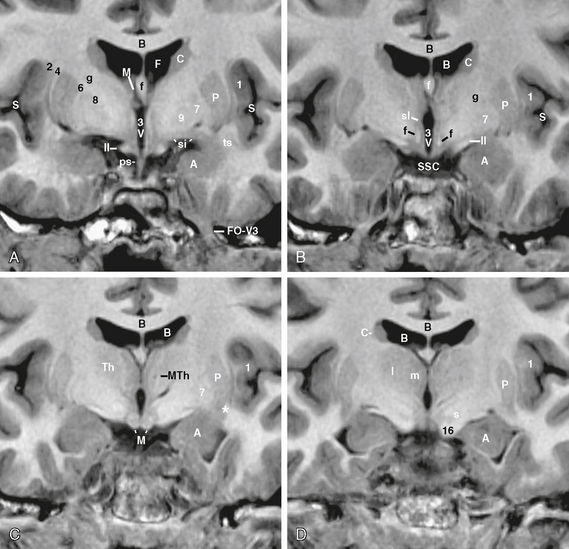
FIGURE 11-11 Corresponding coronal T1W MR images displayed from anterior to posterior. A, The layered gray matter of the cortex and nuclei (white odd numbers) and white matter laminae (black even numbers) correspond to the anatomic images of Figure 11-9. The narrow temporal stem (ts) connects the temporal lobe with the deep frontal lobe. The mandibular division (V3) of the trigeminal nerve emerges from the skull through the foramen ovale (FO). B, The focal diamond-shaped widening of the third ventricle (3V) corresponds to the sulcus limitans (sl), a groove along the lateral wall of the diencephalon, which marks the division between the thalamus superiorly and the hypothalamus inferiorly. It corresponds directly to the sulcus limitans of the early neural tube, which separated the dorsal alar plate (sensory) from the ventral basal plate (motor). C, The mammillothalamic tracts (MTh) pass from the mammillary bodies (M) to the anterior nuclei of the thalami. (See also Figs. 11-10B and 11-24A.) A, amygdala; M, foramen of Monro; ps, pituitary stalk; si, substantia innominata. D, The internal medullary lamina divides the thalamus into medial (m) and combined ventral + lateral (l) nuclear groups. 16, cerebral peduncle.
The term dorsal striatum refers to the vast bulk of the caudate nucleus, putamen, and globus pallidus that is connected predominantly with motor and association areas of the cortex.5,9
The ventral striatum refers to the inferomedial portion of the striatum, including the nucleus accumbens and the greater portion of the olfactory tubercle. These connect predominantly with the limbic system, the orbitofrontal cortex, and the temporal cortex.5
The globus pallidus is a composite structure formed from the lateral (external) nucleus of the globus pallidus (GPe) and the medial (internal) nucleus of the globus pallidus (GPi) (see Figs. 11-1 and 11-9 to 11-11). Grossly, the globus pallidus is a conical structure situated within the hollow cone of the internal capsule, deep to the putamen. The widest portion of the cone is directed laterally, toward the insula, so the lateral nucleus of the globus pallidus is wider than the medial nucleus in all directions. The globus pallidus is traversed by numerous bundles of heavily myelinated fibers, which give it the lighter (pallid) color in fresh specimens.9 The lateral and medial nuclei (GPe and GPi) have distinct afferents, efferents, and functions.5 The anterior commissure traverses the inferior portion of the lateral pallidal nucleus (GPe).
The dorsal pallidum is the major portion of the globus pallidus situated superior to the anterior commissure.5
The ventral pallidum is the small portion of the pallidum situated inferior to the anterior commissure and extending inferiorly into the substantia innominata (see Fig. 11-9).5
The term lenticular nucleus (synonym: lentiform nucleus) refers to the combination of the putamen and the two portions of the globus pallidus (see Figs. 11-6 to 11-8). Because the putamen and globus pallidus lie within the cone of the internal capsule, axial and coronal sections through these nuclei give them a lenticular or sector shape, resembling a slice of pizza. Multiple medullary laminae separate and delimit the individual portions of the lenticular nucleus. These include the external (lateral) medullary lamina between the putamen and GPe, the internal (medial) medullary lamina between GPe and GPi, and the incomplete medullary lamina within the GPi.9
The substantia innominata is an ill-defined flattened cell mass situated immediately inferior to the putamen and globus pallidus (see Fig. 11-9). Grossly, it lies within the basal portion of the brain just above the basal cisterns and extends transversely between the lateral hypothalamus medially and amygdala laterally. It is partly separated from the putamen and globus pallidus by the anterior commissure.9 It contains the basal nucleus of Meynert.
The basal nucleus of Meynert is a population of large cholinergic cells dispersed within the substantia innominata and projecting to the neocortex.9 With other cholinergic nuclei, it provides excitatory input to the entire cerebral cortex, particularly the paralimbic areas.13 The size of this cell population increases with the size of the telencephalon, so it is largest in primates and cetaceans.9
The subthalamic nucleus is a lenticular cell mass situated in the caudal (ventral) diencephalon.1,4,6,9,10 Grossly, it lies just dorsal to the internal capsule where the internal capsule transitions into the cerebral peduncle (Figs. 11-12 to 11-17). The medial portion of the subthalamic nucleus overlaps the rostral portion of the substantia nigra.9 It is encapsulated dorsally by axons, including fibers of the subthalamic fasciculus arising from the GPe.5
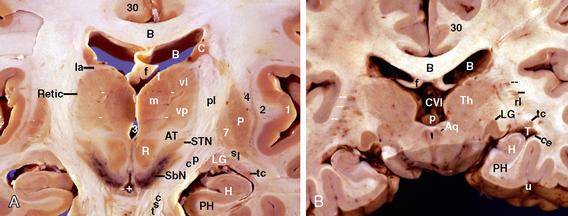
FIGURE 11-12 Gross anatomic coronal plane images displayed from anterior to posterior. A, Posterior lenticular section. The claustrum forms a thin sheet of gray matter between the extreme (2) and the external (4) capsules. This posterior section passes behind the medial nucleus of the globus pallidus, so the lenticular nucleus displays only the putamen (P) and lateral nucleus (7). The sublenticular portion (sl) of the internal capsule separates the lenticular nucleus from the lateral geniculate nucleus (LG) and the tail of the caudate nucleus (tc). The posterior limbs (pl) and cerebral peduncles (cp) continue into the corticospinal tracts (cst) on each side. These enclose the gray matter of the diencephalon and midbrain. Superiorly, the reticular nuclei (Retic) form a layer of gray matter just lateral to the external medullary lamina of the thalamus. The internal medullary laminae of the thalami (white tick marks) separate the thalamic nuclei into medial (m) and ventral groups. In this plane, the ventral group includes the ventrolateral (vl) and ventral posterior (vp) nuclei. The lateral dorsal nucleus (l) of the lateral group is situated superiorly. The lamina affixa (la) encloses the superolateral surface of the thalamus. Inferiorly, the lower third ventricle (3) and interpeduncular fossa (+) mark the midline. From lateral to medial, the cerebral peduncle (cp), substantia nigra (SbN), subthalamic nucleus (STN), area tegmentalis (AT), and red nucleus (R) present a characteristic appearance. The red nuclei resemble snake eyes. The subthalamic nucleus lies between the red nucleus and the substantia nigra, with the equator of the subthalamic nucleus approximately at the level of the upper pole of the red nucleus. The area tegmentalis (AT) flares upward and outward from the red nuclei to pass under the thalami. B, Retrolenticular section. The retrolenticular portion of the internal capsule (rl) is marked only by the caudatolenticular gray bridges (white and black tick marks) that pass through it. The cistern of the velum interpositum (CVI) and pineal gland (p) lie between the posterior thalami (Th) and above the aqueduct and periaqueductal gray matter (Aq) of the midbrain. The lateral geniculate nuclei (LG) show a characteristic “Napoleon’s hat” configuration in coronal plane. The tail of the caudate nucleus (tc) lies at the roof of the temporal horn laterally. The hippocampal formation (H) indents the floor of the temporal horn inferomedially. The collateral sulcus (u) delimits the lateral border of the parahippocampal gyrus (PH). Deep invagination of the collateral sulcus elevates the floor of the temporal horn laterally, forming a bump designated the collateral eminence (ce).
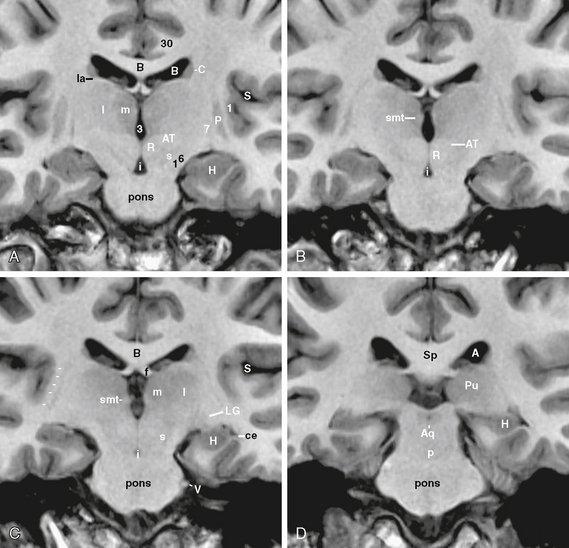
FIGURE 11-13 A to D, Corresponding coronal T1W MR images displayed from anterior to posterior (labels as in Fig. 11-12).16, cerebral peduncle; i, interpeduncular fossa; s, substantia nigra; smt, stria medullaris thalami; V, fifth cranial nerve (trigeminal nerve) emerging from the side of the pons.

FIGURE 11-14 A and B, Anterior commissure and brain stem. Axial cryomicrotome sections. A, The anterior commissure (a) is a highly compact fiber bundle that extends transversely across much of the brain in the shape of bicycle handlebars. From its midline position in the anterior wall of the third ventricle, the anterior commissure first passes anterolaterally to a genu (a). This first segment is related to the caudate nucleus (C) and the nucleus accumbens septi (Ac) anteriorly and to the anterior columns of the fornices (f, f) posteriorly. The anterior limb (al) of the internal capsule just touches the anterior superior surface of the anterior commissure immediately medial to the genu. The second segment of the anterior commissure (outer pair of “a”) angles posteroinferolaterally through the temporal stem into the temporal lobe where it breaks up into individual fascicles too small to resolve. In the midbrain, the prominent habenulointerpeduncular tract (fasciculus retroflexus) (black arrow) grooves the red nucleus (R) on each side. The oculomotor nuclei (CN III) (white arrow) lie just anterolateral to the aqueduct of Sylvius and periaqueductal gray matter. Also labeled are the superior colliculi (small white s, s). B, The distinct discoids of the subthalamic nuclei (small white s in B) lie partially between the red nuclei (R) and the cerebral peduncle (cp). Also labeled are sylvian fissures (S), putamen (P), lateral nucleus of the globus pallidus (7), lateral geniculate nucleus (LG), and medial geniculate nucleus (MG).
(Modified from Naidich TP, Daniels DL, Haughton VM. Deep cerebral structures. In Daniels DL, Haughton VM, Naidich TP [eds]. Cranial and Spinal Magnetic Resonance Imaging: An Atlas and Guide. New York, Raven Press, 1987.)

FIGURE 11-15 A to C, Oblique coronal plane images through the anterior commissure. A, Gross anatomic section through the anterior commissure (a) demonstrates its inferolateral path from the anterior wall of the third ventricle (3V) in the midline under the anterior limb of the internal capsule (al), through the inferior portion of the lateral nucleus of globus pallidus (GPe) (7), under the putamen (P), through the temporal stem, over the amygdala (A), and over the temporal horn (T) into the temporal lobe. Multiple vessels (arrow) penetrate the anterior perforated substance in relation to the segment of the anterior commissure just inferior to the putamen. Inferiorly, the infundibular recess (IR) of the third ventricle (3) passes downward just behind the optic chiasm (II). B and C, Corresponding T1W (B) and T2W (C) MR images in two different patients.
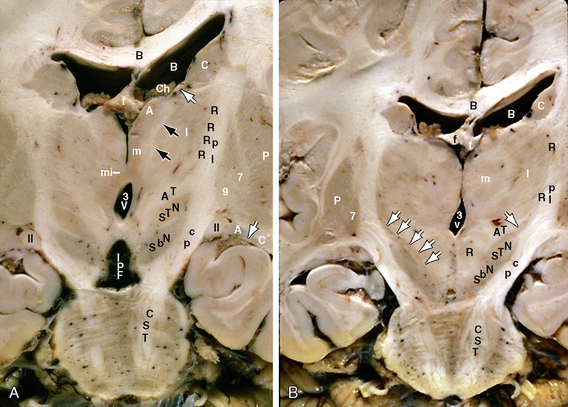
FIGURE 11-16 A and B, Substantia nigra, subthalamic nucleus, zona incerta, and thalamus. Gross coronal anatomic sections through the diencephalic-mesencephalic junction. A, Anterior section through the anterior thalamus, massa intermedia (mi), and interpeduncular fossa (IPF). Superiorly, the stria and vena terminalis (white arrow) lie at the floor of the body (B) of the lateral ventricle in the striothalamic (caudothalamic) groove. They both curve inferiorly along the ventricular wall into the roof of the temporal horn (white arrow). The mammillothalamic tract (black arrows) ascends from the mammillary body to the anterior nucleus of the thalamus on each side. The reticular nuclei of the thalamus (row of Rs) form a thin lamina deep to the posterior limb of the internal capsule (pl) and just lateral to the external medullary lamina of the thalamus. The corticospinal tract (CST) continues inferiorly from the posterior limb through the cerebral peduncle into the pons. The substantia nigra (SbN) and subthalamic nuclei (STN) form stacked tiers of gray matter, enclosed by the cerebral peduncle (cp) and area tegmentalis (AT). Here the term area tegmentalis is used as an umbrella term for the multiple tracts passing through this region to interconnect the roof nuclei of the cerebellum. the red nucleus, the thalamus, and the cerebral hemisphere. B, Posterior to the massa intermedia, in a section through the depths of the interpeduncular fossa, the substantia nigra and subthalamic nucleus have become smaller. The sinuous zona incerta (white arrows) curves through the area tegmentalis (AT) from the medial aspect of the subthalamic nucleus (STN) to the lateral aspect of the thalamus. The habenulointerpeduncular tract (fasciculus retroflexus) curves around the red nucleus (R), forming a prominent white matter tract along its margin. The fibers that arise from the globus pallidus to pass through the H, H1, and H2 fields of Forel are defined by their relation to the subthalamic nucleus and zona incerta (see Fig. 11-19). Superiorly, the internal medullary lamina of the thalamus is seen between the medial (m) and ventral/lateral (v & l) groups of thalamic nuclei.
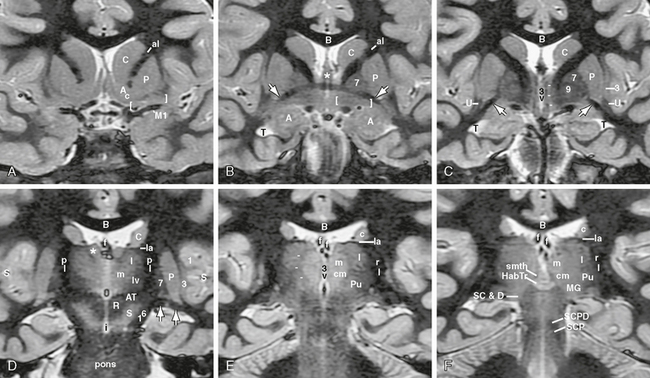
FIGURE 11-17 A to F, Diencephalon. Coronal T2W inversion recovery MR images displayed from anterior to posterior. A, Anteriorly, the head of the caudate nucleus (C) is continuous with the putamen (P) through the nucleus accumbens septi (Ac) anterior and inferior to the anterior limb (al) of the internal capsule. The substantia innominata (between white brackets) lies within the inferior frontal lobe below the putamen and below the white matter that makes up the capsules of the basal ganglia and the radiations through the rostrum of the corpus callosum. The first segment of the middle cerebral artery (M1) runs in the sylvian fissure just below the substantia innominata. B, The anterior commissure (white arrows) forms a prominent landmark. From medial to lateral, the paired anterior columns of the fornices (below asterisk) pass behind the anterior commissure. The anterior limb (al) of the internal capsule just touches the top of the anterior commissure. The anterior commissure passes through the bottom of the lateral nucleus (7) of the globus pallidus, then under putamen (P), through the temporal stem, over the amygdala (A), and over the temporal horn (T) to disperse within the temporal lobe. The substantia innominata (between the brackets) largely lies inferior to the anterior commissure. C, Just behind the anterior commissure, the anterior columns of the fornices (tick marks) pass down to the mammillary bodies on both sides of the third ventricle (3V). The lateral portions of the anterior commissure (white arrows) pass through the temporal stem medial to the uncinate fasciculi (U). This plane passes through the full extent of the lenticular nucleus, including the putamen (P), lateral (7) and medial (9) nuclei of the globus pallidus, and the laminae between them. D, Section through the posterior lenticular nuclei, thalami, and upper brain stem shows the posterior limbs (pl) of the internal capsule and the cerebral peduncles (cp) as two arms of a parenthesis that encloses the paired thalami, red nuclei (R), and substantiae nigrae (S). Within the thalami, MR resolves the paired anterior nuclei (white asterisk on right side), medial (m), lateral (l), and lateral ventral (lv) nuclei. The heavily myelinated area tegmentalis (AT) (H field of Forel) forms a characteristic “upper butterfly wing” superolateral to the red nuclei. It contains a dense feltwork of fibers passing to, emerging from, or bypassing the red nucleus, including fibers from the dentate nucleus to the red nucleus, thalamus, and subthalamus, fibers from the red nucleus to the frontal lobes, and fibers passing from the lenticular nuclei to the thalami.4 Lateral to the posterior limbs (pl) are the residual posterior portions of the insular cortex (1), claustrum (3), putamen (P), and lateral nucleus of the globus pallidus (GPe) (7). The interpeduncular fossa (i) identifies the midline of the midbrain anteriorly. E, Section behind lenticular nuclei shows the retrolenticular (rl) portion of the internal capsule, the lamina affixa (la) atop the thalamus laterally, and the internal medullary lamina (white tick marks) that divides the thalamus into nuclear compartments. At this level the thalamic nuclei include the medial (m), centromedian (cm), lateral (l), and pulvinar (Pu). F, Section through the posterior thalamus and superior colliculi shows the paired myelinated striae medullares thalamorum (smth) passing posteriorly to join the habenular trigones (HabTr). The superior colliculi (SC) and their decussation (D) lie just posteroinferior to the habenulae. Within the midbrain, the superior cerebellar peduncles (SCP) ascend and begin to bend medially toward their decussation (SCPD). The aqueduct and periaqueductal gray matter lie in the midline posterior and inferior to the habenulae and their commissure. MG, medial geniculate nucleus.
The substantia nigra is a large mesencephalic nucleus composed of a pars reticulata (SNr), a pars compacta (SNc), and a small pars lateralis (SNl) (Fig. 11-18). Grossly, the SNr and SNc form nearly separate cell layers oriented parallel with and immediately dorsal to the cerebral peduncle. The pars reticulata forms the layer immediately dorsal to the cerebral peduncle. The pars compacta forms the layer behind the pars reticulata, ventral to the tegmentum. The most rostral portion of the substantia nigra extends superiorly to approach the globus pallidus.9

FIGURE 11-18 A to C, Substantia nigra and neurotransmitters. Axial sections of the midbrain oriented with ventral anterior to correspond to standard MR display. A, Histologic section. Klüver-Barrera stain in which Luxol fast blue stains the myelin bright blue and cresyl violet stains Nissl bodies, nuclei, and nucleoli purplish. The yellow dots identify melanized neurons. B, Postmortem intermediate-weighted 9.4-T MR image of a formalin-fixed midbrain. C, Diagram of the distribution of the dopaminergic neurons (blue dots) of cell groups A9 and A10 and the serotoninergic cell groups of the raphe, B7 and B8 (pink dots). A to C, The substantia nigra (SbN) lies immediately dorsomedial to the cerebral peduncles (CP) and ventrolateral to the red nucleus (R) and the medial lemniscus (ML). Substantia nigra pars reticulata (SNr) lies ventrally, against the cerebral peduncle. Substantia nigra pars compacta (SNc) lies dorsomedial to SNr. A small dorsolateral component of substantia nigra is designated pars lateralis (SNl). The dopaminergic neurons of SNc and SNl form cell group A9 on each side. These are continuous with each other through the midline dopaminergic cell group A10. Serotonergic cell groups B7 and B8 (pink dots
Stay updated, free articles. Join our Telegram channel

Full access? Get Clinical Tree


